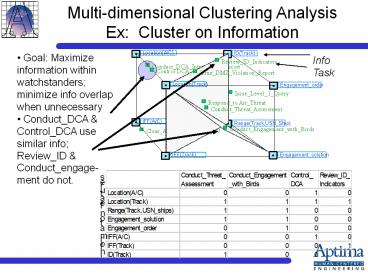Multi-dimensional Clustering Analysis Ex: Cluster on Information - PowerPoint PPT Presentation
Title:
Multi-dimensional Clustering Analysis Ex: Cluster on Information
Description:
Away No. OUTCOME Variables. DECISION Variables. INFORMATION Variables. ACTION Variables ... while Monitoring system. for jamming. TCTC Mission. Define Threats ... – PowerPoint PPT presentation
Number of Views:5050
Avg rating:5.0/5.0
Title: Multi-dimensional Clustering Analysis Ex: Cluster on Information
1
Multi-dimensional Clustering AnalysisEx
Cluster on Information
- Goal Maximize information within watchstanders
minimize info overlap when unnecessary - Conduct_DCA Control_DCA use similar info
Review_ID Conduct_engage-ment do not.
Info Task
2
Phase D Engineering Team Interactions
- Uniquely assign tasks when possible to minimize
routine communications between team members - May need to split tasks if individuals are
overloaded - Detailed Modeling Tool
Note Splitting tasks introduces new
communication workload
3
Intra- and Inter-Task Analysis
4
Example Objective Balancing Workload in the
Team
Instant Workload
Threshold
0
Objective 1
Workload Accumulation Balance
DM1
DM2
DM3
DM4
DM5
5
Notional Workload Analysis
6
Outline of Presentation
- Value of modeling C2 Organizations
- Prescriptive vs. descriptive modeling
- Model-Based Experimentation
- TIDE modeling approach
- C2 Design Example AWACS
- How to use TIDE products
7
AWACS Design Challenge
How do you design an optimal command control
teams for complex, variable AWACS missions to
take advantage of advanced information fusion
technology?
- TIDE Design Approach
- Mission analysis
- What needs to be done
- What information is available
- Task analysis
- How is it done
- What information is used
- Organizational analysis
- How is information shared
- Who does what
8
Example AWACS Crew Optimization
- Human-Centered Re-Engineering of AWACS Command
and Control Teams (REAC2T) - Phase III SBIR Project funded by AWACS System
Program Office ESC, Hanscom AFB - Demonstrate proven, scientific approach to C2
team design in AWACS domain - Team Integrated Design Environment (TIDE)
- Present ACC/Wing with proof-of-concept for crew
optimization - Evaluate impact of information fusion on mission
performance and operator functions - Introduce optimized team structures to enhance
mission performance
9
AWACS Example Inputs to Mission Model
- Mission decomposition and evaluation
- Work with operational community to define current
approach to mission completion - CONOPS, tactics, roles, and responsibilities
- Red Flag Spin-Up Training
- Tinker AFB
- Live Fly Red Flag Exercises
- Five flights, Nellis AFB
- Cognitive Task Analysis
- Wing Tactics Office, Tinker AFB
- SD instructors Fighter Weapons School, Nellis AFB
10
TIDE Prototype Software
- Mission task graphs are converted into data
tables to serve as input for optimization
algorithms
11
Preliminary Results Baseline 14 Operator Task
Distribution
Max Workload 1400
Colors represent unique operational tasks
12
Impact of Technology (MSI) InsertionNon-Optimize
d 14 Operator Configuration
Max Workload 950
Colors represent unique operational tasks
13
Impact of Technology (MSI) InsertionOptimized
14 Operator Configuration
Max Workload 750
Colors represent unique operational tasks
14
Impact of Technology (MSI) InsertionOptimized
12 Operator Configuration
Max Workload 800
Colors represent unique operational tasks
15
Internal Communication Outgoing Messages
Baseline
MSI Non-Optimized 14
160
500
1. Technology Insertion
2. Optimal Team
MSI Optimized 14
MSI Optimized 12
3. Manning Optimization
16
Summary Model-based Re-Engineering of AWACS
Command Control Teams (REAC2T)
17
Outline of Presentation
- Value of modeling C2 Organizations
- Prescriptive vs. descriptive modeling
- Model-Based Experimentation
- TIDE modeling approach
- C2 Design Example
- How to use TIDE products
18
TIDE Model Products
- Detailed Specification of Team Roles
- When Tasks are performed
- How Decision are made
- What Resources are used
- What Information is used
- What Communications are required
19
Multiple Applications of TIDE Model
Interface Design
20
Model-driven Measurement Process
Success in Meeting Training Objectives
How well are training objectives met?
Learning Objectives
Success at JTF Certification
in JTF Environment
Measurement
Improve by X
Challenges
Competencies
KSA Assessment
Knowledge, Skills,
Individual
What
KSAs
do learners have/lack?
and Abilities
Team
Diagnose individuals needs for additional
training
Team-of-Teams
Stimulated or Trained by...
Performance Measures by Task
Tasks
How well did learners perform?
Theories of
Performance Link
Skills to Behaviors to
Tasks
Put together into vignettes...
Scenario
Stories and
TIDE Model
MOPs Measurement Tools
events
Subject Matter Experts
21
TIDE Integrated Toolset
Task Network Simulation
SIMULATION-BASED EVALUATION
ANALYSIS
DESIGN
22
Some Current Military Applications of the TIDE
Modeling Methods and Tools
- Joint Task Force Adaptive Architectures for
Command and Control (A2C2) - Next Generation Navy Surface Ships (SC-21/DD-21)
- Human-Centered Re-Engineering of AWACS Command
and Control Teams (REAC2T) - Uninhabited Combat Air Vehicle (UCAV) Control
Center - Kwajalein Radar/Missile Control Center (ATIDS)
- Air Operations for Time Critical Targets (JFACC)
- Time Critical Targeting Cell in Air operations
(CAOC) - Effects-Based Operations in Operations Center
(EBO) - Army Future Combat Systems (FCS)
- Global Wargame JTF Org. Design and Assessment
- .
23
Summary Why Model C2?
- TIDE is a method to optimize decision-making
organizations to capitalize on advanced
technology - Model-based organizational structures are
congruent with mission needs - Modeling guides experimentation and performance
assessment - Analysis and design tool for system designers
- Cost and risk reduction
- New technology payoffs
- Mission/organization model serves multiple
purposes - Organizational design Provide alternative,
optimized organizations - Team training Highlight areas for team training
- Synthetic tasks Develop environments to train
and evaluate teams - Interface design Functional definition of GUI































